Deepak Gupta
MoEMoE: Question Guided Dense and Scalable Sparse Mixture-of-Expert for Multi-source Multi-modal Answering
Mar 08, 2025Abstract:Question Answering (QA) and Visual Question Answering (VQA) are well-studied problems in the language and vision domain. One challenging scenario involves multiple sources of information, each of a different modality, where the answer to the question may exist in one or more sources. This scenario contains richer information but is highly complex to handle. In this work, we formulate a novel question-answer generation (QAG) framework in an environment containing multi-source, multimodal information. The answer may belong to any or all sources; therefore, selecting the most prominent answer source or an optimal combination of all sources for a given question is challenging. To address this issue, we propose a question-guided attention mechanism that learns attention across multiple sources and decodes this information for robust and unbiased answer generation. To learn attention within each source, we introduce an explicit alignment between questions and various information sources, which facilitates identifying the most pertinent parts of the source information relative to the question. Scalability in handling diverse questions poses a challenge. We address this by extending our model to a sparse mixture-of-experts (sparse-MoE) framework, enabling it to handle thousands of question types. Experiments on T5 and Flan-T5 using three datasets demonstrate the model's efficacy, supported by ablation studies.
Overview of TREC 2024 Medical Video Question Answering (MedVidQA) Track
Dec 15, 2024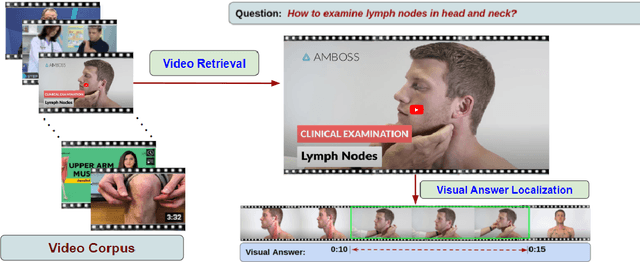
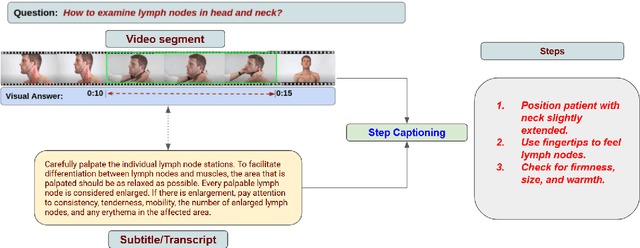

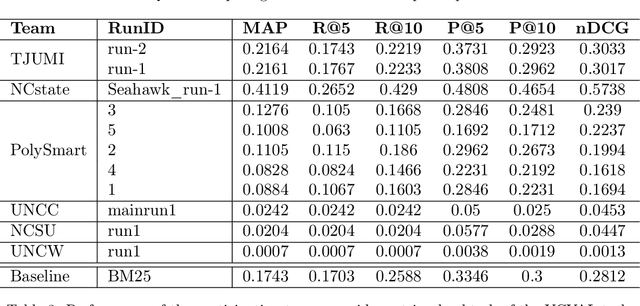
Abstract:One of the key goals of artificial intelligence (AI) is the development of a multimodal system that facilitates communication with the visual world (image and video) using a natural language query. Earlier works on medical question answering primarily focused on textual and visual (image) modalities, which may be inefficient in answering questions requiring demonstration. In recent years, significant progress has been achieved due to the introduction of large-scale language-vision datasets and the development of efficient deep neural techniques that bridge the gap between language and visual understanding. Improvements have been made in numerous vision-and-language tasks, such as visual captioning visual question answering, and natural language video localization. Most of the existing work on language vision focused on creating datasets and developing solutions for open-domain applications. We believe medical videos may provide the best possible answers to many first aid, medical emergency, and medical education questions. With increasing interest in AI to support clinical decision-making and improve patient engagement, there is a need to explore such challenges and develop efficient algorithms for medical language-video understanding and generation. Toward this, we introduced new tasks to foster research toward designing systems that can understand medical videos to provide visual answers to natural language questions, and are equipped with multimodal capability to generate instruction steps from the medical video. These tasks have the potential to support the development of sophisticated downstream applications that can benefit the public and medical professionals.
Overview of TREC 2024 Biomedical Generative Retrieval (BioGen) Track
Nov 27, 2024



Abstract:With the advancement of large language models (LLMs), the biomedical domain has seen significant progress and improvement in multiple tasks such as biomedical question answering, lay language summarization of the biomedical literature, clinical note summarization, etc. However, hallucinations or confabulations remain one of the key challenges when using LLMs in the biomedical and other domains. Inaccuracies may be particularly harmful in high-risk situations, such as making clinical decisions or appraising biomedical research. Studies on the evaluation of the LLMs' abilities to ground generated statements in verifiable sources have shown that models perform significantly worse on lay-user generated questions, and often fail to reference relevant sources. This can be problematic when those seeking information want evidence from studies to back up the claims from LLMs[3]. Unsupported statements are a major barrier to using LLMs in any applications that may affect health. Methods for grounding generated statements in reliable sources along with practical evaluation approaches are needed to overcome this barrier. Towards this, in our pilot task organized at TREC 2024, we introduced the task of reference attribution as a means to mitigate the generation of false statements by LLMs answering biomedical questions.
Enhancing Deep Learning based RMT Data Inversion using Gaussian Random Field
Oct 22, 2024Abstract:Deep learning (DL) methods have emerged as a powerful tool for the inversion of geophysical data. When applied to field data, these models often struggle without additional fine-tuning of the network. This is because they are built on the assumption that the statistical patterns in the training and test datasets are the same. To address this, we propose a DL-based inversion scheme for Radio Magnetotelluric data where the subsurface resistivity models are generated using Gaussian Random Fields (GRF). The network's generalization ability was tested with an out-of-distribution (OOD) dataset comprising a homogeneous background and various rectangular-shaped anomalous bodies. After end-to-end training with the GRF dataset, the pre-trained network successfully identified anomalies in the OOD dataset. Synthetic experiments confirmed that the GRF dataset enhances generalization compared to a homogeneous background OOD dataset. The network accurately recovered structures in a checkerboard resistivity model, and demonstrated robustness to noise, outperforming traditional gradient-based methods. Finally, the developed scheme is tested using exemplary field data from a waste site near Roorkee, India. The proposed scheme enhances generalization in a data-driven supervised learning framework, suggesting a promising direction for OOD generalization in DL methods.
Bioimpedance a Diagnostic Tool for Tobacco Induced Oral Lesions: a Mixed Model cross-sectional study
Aug 21, 2024Abstract:Introduction: Electrical impedance spectroscopy (EIS) has recently developed as a novel diagnostic device for screening and evaluating cervical dysplasia, prostate cancer, breast cancer and basal cell carcinoma. The current study aimed to validate and evaluate bioimpedance as a diagnostic tool for tobacco-induced oral lesions. Methodology: The study comprised 50 OSCC and OPMD tissue specimens for in-vitro study and 320 subjects for in vivo study. Bioimpedance device prepared and calibrated. EIS measurements were done for the habit and control groups and were compared. Results: The impedance value in the control group was significantly higher compared to the OPMD and OSCC groups. Diagnosis based on BIS measurements has a sensitivity of 95.9% and a specificity of 86.7%. Conclusion: Bioimpedance device can help in decision-making for differentiating OPMD and OSCC cases and their management, especially in primary healthcare settings. Keywords: Impedance, Cancer, Diagnosis, Device, Community
Surgical Feature-Space Decomposition of LLMs: Why, When and How?
May 17, 2024Abstract:Low-rank approximations, of the weight and feature space can enhance the performance of deep learning models, whether in terms of improving generalization or reducing the latency of inference. However, there is no clear consensus yet on \emph{how}, \emph{when} and \emph{why} these approximations are helpful for large language models (LLMs). In this work, we empirically study the efficacy of weight and feature space decomposition in transformer-based LLMs. We demonstrate that surgical decomposition not only provides critical insights into the trade-off between compression and language modelling performance, but also sometimes enhances commonsense reasoning performance of LLMs. Our empirical analysis identifies specific network segments that intrinsically exhibit a low-rank structure. Furthermore, we extend our investigation to the implications of low-rank approximations on model bias. Overall, our findings offer a novel perspective on optimizing LLMs, presenting the low-rank approximation not only as a tool for performance enhancements, but also as a means to potentially rectify biases within these models. Our code is available at \href{https://github.com/nyunAI/SFSD-LLM}{GitHub}.
Interpretable User Satisfaction Estimation for Conversational Systems with Large Language Models
Mar 19, 2024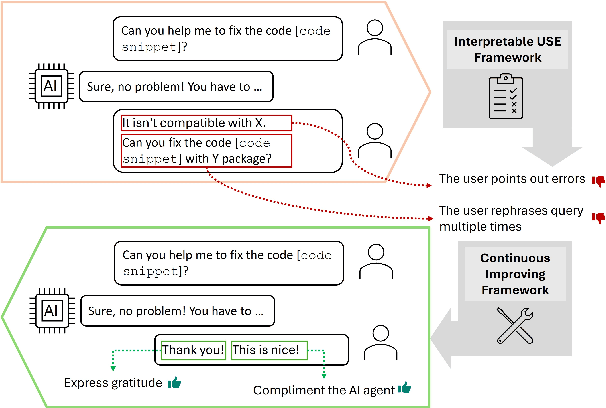

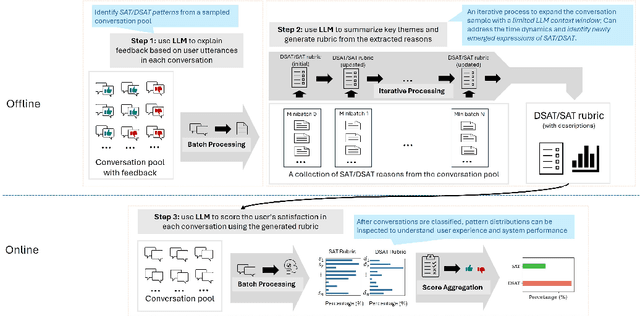

Abstract:Accurate and interpretable user satisfaction estimation (USE) is critical for understanding, evaluating, and continuously improving conversational systems. Users express their satisfaction or dissatisfaction with diverse conversational patterns in both general-purpose (ChatGPT and Bing Copilot) and task-oriented (customer service chatbot) conversational systems. Existing approaches based on featurized ML models or text embeddings fall short in extracting generalizable patterns and are hard to interpret. In this work, we show that LLMs can extract interpretable signals of user satisfaction from their natural language utterances more effectively than embedding-based approaches. Moreover, an LLM can be tailored for USE via an iterative prompting framework using supervision from labeled examples. The resulting method, Supervised Prompting for User satisfaction Rubrics (SPUR), not only has higher accuracy but is more interpretable as it scores user satisfaction via learned rubrics with a detailed breakdown.
Beyond Uniform Scaling: Exploring Depth Heterogeneity in Neural Architectures
Feb 19, 2024Abstract:Conventional scaling of neural networks typically involves designing a base network and growing different dimensions like width, depth, etc. of the same by some predefined scaling factors. We introduce an automated scaling approach leveraging second-order loss landscape information. Our method is flexible towards skip connections a mainstay in modern vision transformers. Our training-aware method jointly scales and trains transformers without additional training iterations. Motivated by the hypothesis that not all neurons need uniform depth complexity, our approach embraces depth heterogeneity. Extensive evaluations on DeiT-S with ImageNet100 show a 2.5% accuracy gain and 10% parameter efficiency improvement over conventional scaling. Scaled networks demonstrate superior performance upon training small scale datasets from scratch. We introduce the first intact scaling mechanism for vision transformers, a step towards efficient model scaling.
Faster and Lighter LLMs: A Survey on Current Challenges and Way Forward
Feb 02, 2024


Abstract:Despite the impressive performance of LLMs, their widespread adoption faces challenges due to substantial computational and memory requirements during inference. Recent advancements in model compression and system-level optimization methods aim to enhance LLM inference. This survey offers an overview of these methods, emphasizing recent developments. Through experiments on LLaMA(/2)-7B, we evaluate various compression techniques, providing practical insights for efficient LLM deployment in a unified setting. The empirical analysis on LLaMA(/2)-7B highlights the effectiveness of these methods. Drawing from survey insights, we identify current limitations and discuss potential future directions to improve LLM inference efficiency. We release the codebase to reproduce the results presented in this paper at https://github.com/nyunAI/Faster-LLM-Survey
Rethinking Compression: Reduced Order Modelling of Latent Features in Large Language Models
Dec 12, 2023Abstract:Due to the substantial scale of Large Language Models (LLMs), the direct application of conventional compression methodologies proves impractical. The computational demands associated with even minimal gradient updates present challenges, particularly on consumer-grade hardware. This paper introduces an innovative approach for the parametric and practical compression of LLMs based on reduced order modelling, which entails low-rank decomposition within the feature space and re-parameterization in the weight space. Notably, this compression technique operates in a layer-wise manner, obviating the need for a GPU device and enabling the compression of billion-scale models within stringent constraints of both memory and time. Our method represents a significant advancement in model compression by leveraging matrix decomposition, demonstrating superior efficacy compared to the prevailing state-of-the-art structured pruning method.
 Add to Chrome
Add to Chrome Add to Firefox
Add to Firefox Add to Edge
Add to Edge